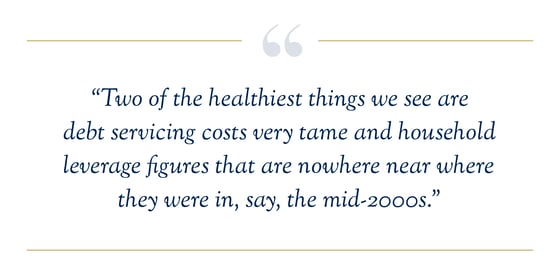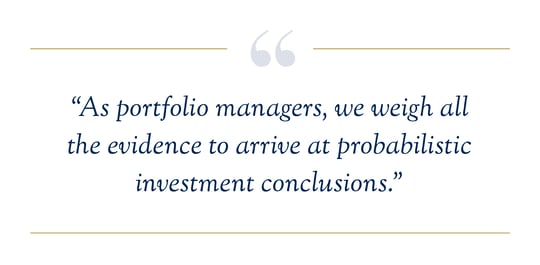U.S. Consumer Checkpoint: Healthy Signs, Dismal Sentiment
Don’t ever bet against the American consumer. That’s how the saying goes, but Chair Jerome Powell at the Federal Reserve continues to take aim at the demand side of the economy. Despite a surge in interest rates that effectively began more than a year ago when the U.S. 2-year Treasury rate began to rise from near zero to above 4.3% by today, the labor market remains strong and excess savings among households is still robust. There have been some signs of consumer weakness as credit card usage is on the rise and pent-up savings balances from the pandemic are beginning to dwindle. Confidence, meanwhile, is lousy to say the least.
Ahead of the key holiday shopping season, a check-in on the strength of the American consumer is appropriate. Normally, healthy consumption levels translate into a robust economic backdrop — that is not so today. We are in a so-called “good news is bad news environment” in which the more we spend, the firmer the Fed’s foot is on the brake pedal in terms of its monetary policy mission to stimy inflation. What if, though, the consumer weathers this inflationary (and potentially recessionary) storm and the Fed is able to achieve its mission to bring down the rate of inflation? It’s a scenario that should not be discounted amid so much negativity. Let’s review the state of the consumer and what it might mean for markets.

Consumers’ Income and Balance Sheets
The labor market remains very much in favor of the worker. While the August reading of the Job Openings and Labor Turnover report showed a decline in available positions, the September employment report revealed yet another solid month of net jobs created, perhaps to the chagrin of the Fed.i With an unemployment rate hovering at its lowest level since 1969, folks can endure higher prices for everyday goods and services, but they are beginning to get strained to an extent.ii Consider that real wages, taking inflation into account, actually fell by 0.1% from August to September. On a year-on-year basis, real earnings among workers dropped a hefty 3.0%.iii That’s born out in real retail sales data that peaked way back in March 2021 — a time when Covid stimulus and aid measure had their full impact.iv Interestingly, lower real wages amid high nominal sales growth could be a recipe to support corporate profit margins in the coming quarters.
Business owners and wealth managers know that analyzing all financial statements is imperative when making economic decisions. The good news is that household balance sheets remain strong. Just recently, Bank of America reported that the average FICO score among its cardholders was a stout 770, up two points from a year earlier.v Worrying some analysts is a jump in consumer credit levels which began back in early 2021 while the U.S. Personal Saving Rate notches its lowest level since 2008. Perhaps folks do not want to dip into the $1.7 trillion of excess savings they still have stashed compared with pre-pandemic levels. Two of the healthiest things we see are debt servicing costs very tame and household leverage figures that are nowhere near where they were in, say, the mid-2000s. Even if we see an economic downturn, people appear positioned well to handle it.

Consumer Confidence and Investor Sentiment
Is everything coming up roses? Of course not. Inflation continues to run high, and the labor market will likely turn worse next year as the markets grapple with much tighter monetary policy. Front and center, however, remains inflation. It is a “look at what I do, not what I say” economic situation as spending is up while confidence is in the gutter. The October reading of the University of Michigan Consumer Sentiment survey showed a slight rise, but it’s not far from its August 2022 all-time low.vi The other popular measure of consumer optimism comes from the Conference Board — it is more sanguine since it measures how folks feel about the employment situation.vii We think both gauges might turn higher so long as gas prices are held in check.
While consumer vibes are down, but not out, investor sentiment remains decidedly bearish. Can you blame them? The traditional 60/40 index portfolio, net of inflation, is on pace for its worst year in a century.viii The American Association of Individual Investors (AAII) runs a weekly survey asking its members where they see stock prices headed over the coming six months. Spoiler alert: Members are incredibly bearish.ix This year tracks as the most ”net bearish” on record (since 1988).x Finally, the National Association of Active Investment Managers (NAAIM) runs a weekly poll of the average exposure to U.S. equity markets reported by its members — it has been trending bearishly lower since early 2021. These are all hallmark contrarian indicators that might help set the stage for a decent 2023 in the stock and bond markets.
Where to Find Opportunities
As portfolio managers, we weigh all the evidence to arrive at probabilistic investment conclusions. We must also take a Bayesian approach whereby stances are tweaked as new information arrives. Dana’s portfolio managers continue to like how many domestic small-cap equities are valued right now. With a strong U.S. dollar, a generally healthy consumer, and a stock market that has priced in much pessimism, 2023 could shape up to be a year of solid returns for small caps. Our Large Cap Equity Fund and ESG Fund could also deliver good returns as volatility creates a ripe market for stock pickers. What’s more, a new era of higher interest rates should be a tailwind for Dana’s relative value approach.

Where Hope and Reality Meet
Of course, there is no getting around the Fed’s impact on markets. The hope is that after 14 months of a rising 2-year Treasury rate (a market-based gauge of expected Fed policy), stocks and bonds have priced in the higher-rate regime. If the FOMC indeed ends its rate-hike cycle sometime early next year without major job market losses, the consumer should be primed to turn more hopeful.xi
Dana is optimistic about the future of investing. Valuations have been reset while the fixed-income space now offers both portfolio managers and investors solid yields. The consumer can come out of this strange economic period of high nominal growth and discouraging inflation in good shape. Even if things do not pan out well in the economy, stocks and bonds are priced much more attractively now than a year ago.


